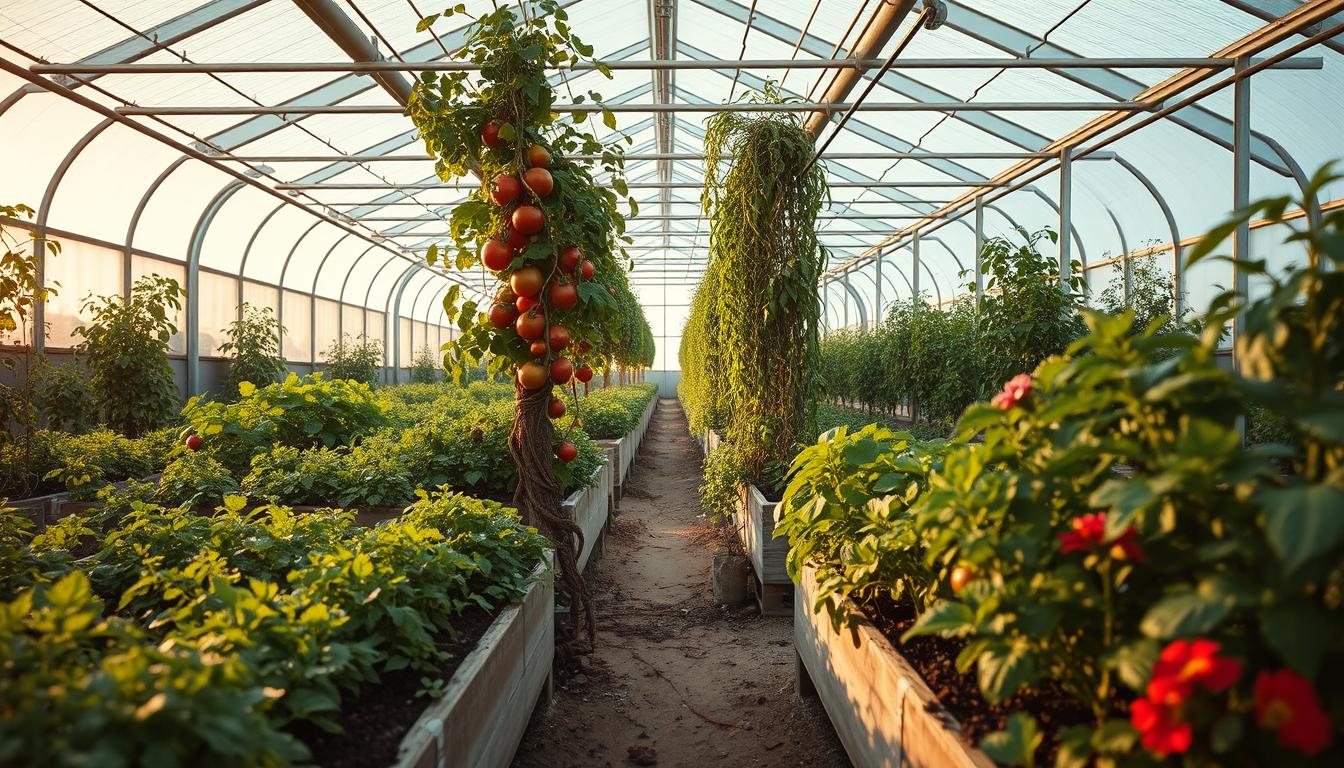Imagine picking fresh tomatoes in December or growing delicate seedlings while it snows outside. This isn’t magic – it’s real with greenhouse gardening. For ages, people have used these spaces to grow plants all year.
Our love for growing plants has led to many changes. We’ve moved from simple cold frames to advanced, climate-controlled greenhouses. Today, you can find everything from small plastic hoop houses to big glass structures with smart systems.
Season extension techniques help gardeners in every climate zone grow all year. Whether you want fresh herbs in winter or want to grow more, these spaces make it possible. They open up new ways to grow.
Greenhouses do more than just let you grow food all year. They protect your plants from bad weather, pests, and diseases. In this guide, we’ll cover how to pick the best greenhouse and grow plants all year.
The Magic of Growing Beyond Seasons
Greenhouse gardening is truly magical because it lets us grow plants all year. While outdoor gardens freeze in winter, greenhouses stay warm. This lets us keep growing and harvesting food, even when it’s cold outside.
This new way of growing has changed how we think about food. It lets us grow food all year, not just in certain seasons.
Why Gardeners Are Embracing Controlled Environments
In the United States, more gardeners are choosing greenhouses. They love the idea of growing plants in perfect conditions, no matter the weather outside.
Greenhouses protect plants from bad weather. They also let us grow plants that wouldn’t survive in many places. This is why so many gardeners are excited about greenhouses.
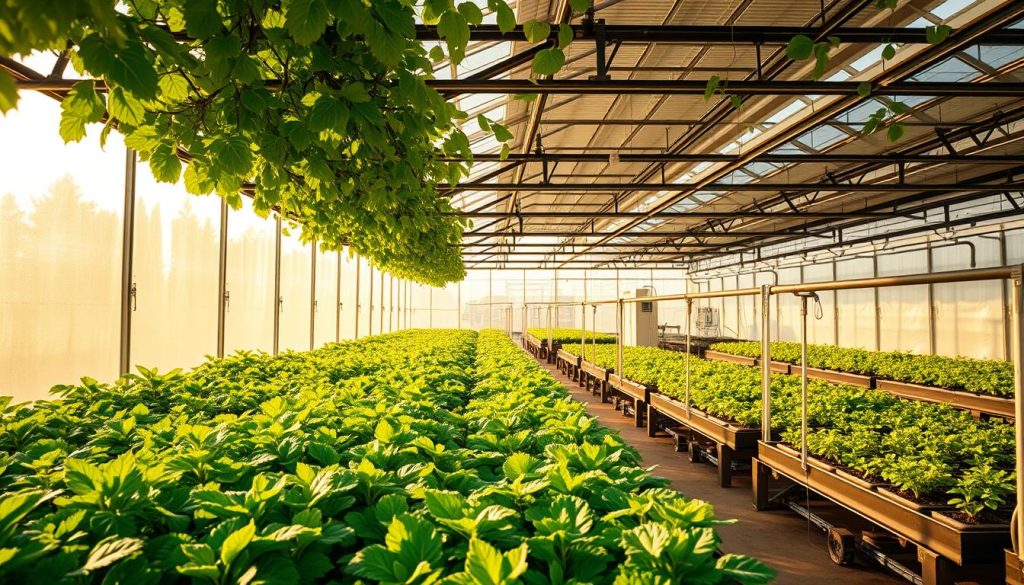
Maria Gonzalez from Minnesota loves her greenhouse. “I never thought I’d grow citrus here,” she says. “Now, I have lemons all year, even when it’s freezing outside.”
Personal Stories from Year-Round Growers
James Wilson in Maine loves his 8×10 greenhouse. “I used to grow for only four months,” he says. “Now, I have fresh food every day, even in January.”
Sophia Chen in Arizona had a different problem. “Our summers were too hot for lettuce and spinach,” she remembers. “But my greenhouse with cooling systems gives me perfect greens, even when it’s 110°F outside.”
These stories show how greenhouses have changed gardening. It’s no longer just a seasonal hobby. It’s a year-round passion.
Breaking Free from Traditional Growing Calendars
Greenhouse gardening lets us break free from old growing calendars. We can try new things and grow plants at any time. This freedom is exciting for gardeners.
Many gardeners enjoy starting summer crops in February. They harvest fall crops in December. This cycle makes gardening more sustainable and fulfilling.
Comparing Outdoor vs. Greenhouse Yields
Greenhouses can produce more food in less space. They use fewer resources too. This makes them very productive.
| Crop | Outdoor Yield (per sq ft) | Greenhouse Yield (per sq ft) | Season Length Outdoor | Season Length Greenhouse |
|---|---|---|---|---|
| Tomatoes | 5-10 lbs | 20-30 lbs | 3-4 months | 8-10 months |
| Lettuce | 2-3 crops | 8-10 crops | Spring/Fall only | Year-round |
| Peppers | 2-3 lbs | 7-10 lbs | 4-5 months | 9-12 months |
| Herbs | Seasonal harvest | Continuous harvest | Varies by region | 12 months |
Greenhouse gardening also means less crop loss. This makes gardening more reliable and rewarding. It’s no longer just a gamble.
The Science Behind Greenhouse Gardening
Greenhouse gardening uses natural science to create perfect spots for plants to grow all year. These special places work with nature but also let gardeners control the growing conditions. Knowing how they work helps you take better care of your greenhouse.
Temperature and Climate Control Fundamentals
Greenhouse gardening is all about managing light, heat, and moisture. Today’s systems let gardeners keep the right temperature for plants, no matter the weather outside. In winter, greenhouses keep the sun’s warmth inside. In summer, they cool down to prevent overheating.
The Greenhouse Effect Explained
The greenhouse effect in your garden is like the one in the sky, but it helps plants. Sunlight goes through the clear top (glass or plastic) and warms the plants and surfaces inside. This warmth stays inside, making the greenhouse warmer than outside.
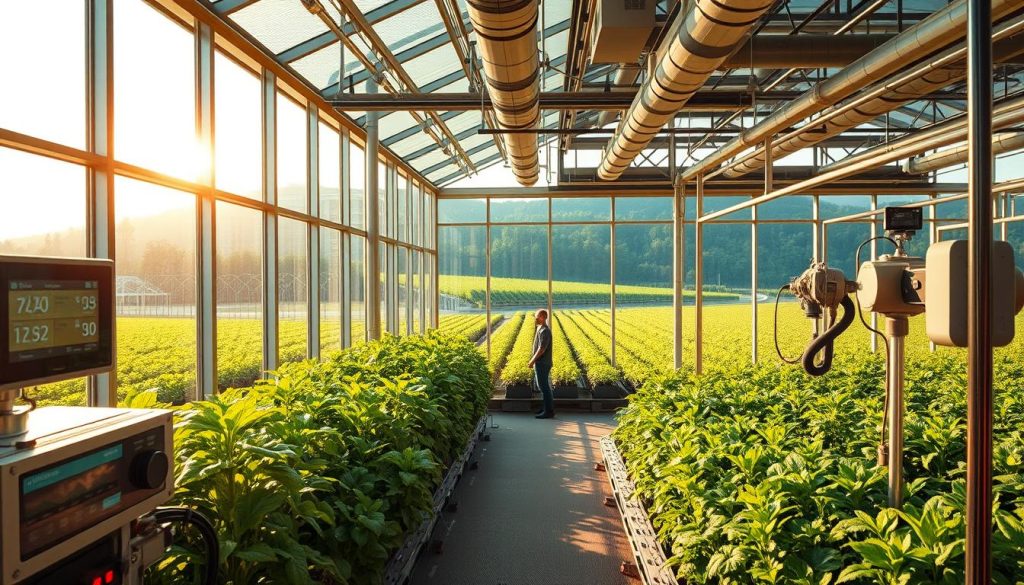
This warmth is perfect for growing plants longer than usual. It’s great because it uses no electricity to work, making it very sustainable.
Protection from Environmental Stressors
Greenhouses protect plants from many outdoor dangers. They keep out heavy rains, hail, and strong winds that could harm plants. They also block pests and diseases that rain and wind can spread.
With less stress, plants can grow stronger and produce more. This means healthier plants, longer harvests, and less need for chemicals.
Resource Efficiency and Conservation
Greenhouse gardening is very good for the environment. It uses water wisely because it doesn’t evaporate as much. Many gardeners collect rainwater from their greenhouses, making a closed water cycle.
It’s also better for nutrients because they don’t get washed away. Plants lose fewer nutrients to pests, disease, and weather. This means more food from the same amount of effort.
Greenhouses also use space better. Plants can be planted closer together and grown up walls. This makes the most of every square foot, which is key to sustainable gardening.
Types of Greenhouse Structures for Every Space and Budget
Greenhouse structures range from DIY projects to advanced climate-controlled spaces. Whether you’re a casual gardener or a serious enthusiast, there’s a greenhouse for you. Each option meets different needs and budgets.
Freestanding vs. Attached Greenhouses
Freestanding greenhouses stand alone, offering lots of light and design freedom. They cost between $1,000 to $10,000, depending on size and materials. This lets you place them anywhere you want.
Attached greenhouses, or lean-to greenhouses, connect to your home or garage. They cost 20-30% less than freestanding ones. They also save on heating costs by sharing a wall with your home.
Choosing between freestanding and attached greenhouses depends on your space and needs. Freestanding ones offer more room and flexibility. Attached ones save space and energy.
Space-Saving Options: Mini Greenhouses and Cold Frames
Even with little space, you can still grow plants. Mini greenhouses are 2-6 feet tall and fit on small areas. They cost $50 to $300 and are great for seedlings and small plants.
Cold frames are simple and low-cost. They’re like bottomless boxes with clear tops. They cost $30 to $200 and extend your growing season by weeks.
Window-mounted greenhouses attach to your windows. They use your home’s heat and don’t take up ground space. They cost $100-$400 and are ideal for small spaces.
High-Tech Solutions for Serious Enthusiasts
For those who want the best growing conditions, high-performance greenhouses are the answer. They have durable materials and advanced climate control. These greenhouses cost $5,000 to $25,000 but offer great returns through longer growing seasons.
These premium greenhouses are designed for different weather conditions. They have strong frames for snowy areas and special ventilation for hot climates.
Automated Climate Control Systems
Modern greenhouses use automated systems for perfect growing conditions. Basic systems start at $200-$500 and include temperature-controlled fans and vents. They make gardening easier with less effort.
More advanced systems have humidity sensors, irrigation controllers, and even smartphone apps. They cost $500-$2,000 but save time and improve results. They make gardening easier and more efficient.
| Greenhouse Type | Price Range | Space Required | Best For | ROI Potential |
|---|---|---|---|---|
| Freestanding | $1,000-$10,000 | 80-500 sq ft | Serious gardeners with available yard space | High – year-round growing |
| Attached/Lean-to | $800-$8,000 | 40-200 sq ft | Home gardeners with limited space | Very high – energy efficient |
| Mini Greenhouse | $50-$300 | 4-20 sq ft | Beginners, seed starting, small spaces | Moderate – seasonal use |
| Cold Frame | $30-$200 | 4-16 sq ft | Season extension, hardening off | High – low cost, effective |
| High-Tech Automated | $5,000-$25,000+ | 100-1,000+ sq ft | Commercial growers, enthusiasts | Variable – depends on crops |
Setting Up Your First Greenhouse
Starting your first greenhouse is all about planning. It turns a simple space into a thriving farm. You don’t need to be an expert. Just be prepared and know a few key things. This way, you’ll have a system that grows food all year.
Selecting the Optimal Location and Orientation
The right spot for your greenhouse is key. Pick a place that gets at least 6 hours of direct sunlight in winter. In the Northern Hemisphere, south-facing is best for all-year light.
Be close to water and electricity for easy access. Good drainage stops flooding. Also, place it where winds aren’t too strong, like near a fence or building.
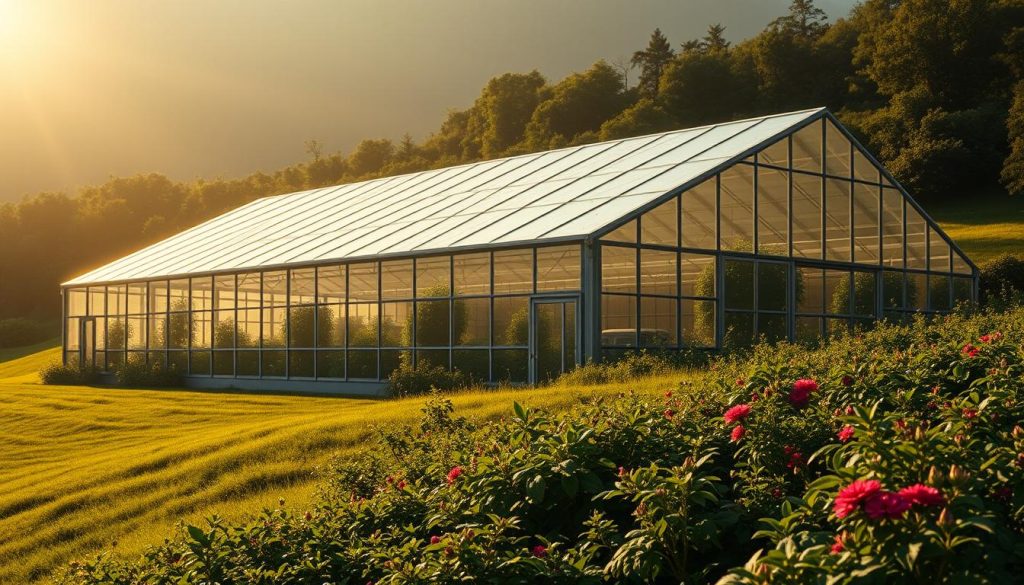
Essential Equipment and Materials Checklist
More than just a structure, you’ll need:
- Thermometer and humidity gauge to monitor conditions
- Irrigation system (simple watering cans or automated drip systems)
- Potting soil, containers, and seed starting supplies
- Basic hand tools for planting and maintenance
- Shade cloth for summer heat management
- Ventilation equipment (manual or automatic vents)
Benches, Shelving, and Growing Surfaces
Organizing your space well is important. Use waist-high benches to avoid back pain. Add tiered shelving to use wall space.
Choose from wooden benches to growing tables with drainage. Make sure paths are wide enough for easy access.
Climate Management for Beginners
Keeping the right conditions is crucial. Use a thermometer/hygrometer to track temperature and humidity. Most plants like 65-75°F during the day and 10 degrees cooler at night.
Heating, Cooling, and Ventilation Basics
For heating, electric or propane heaters work well. In summer, use shade cloth and ventilation to cool down.
Ventilation helps with temperature, humidity, and air flow. Start with simple roof vents and upgrade later if needed.
You can start simple and add more as you learn. Many gardeners begin with the basics and add more as they go.
Year-Round Planting Strategies and Schedules
Greenhouse gardening is amazing because it lets you grow food all year. By planning your planting, you can always have fresh food, no matter the weather.
Winter Growing: Cold-Hardy Vegetables and Herbs
Winter is the time for cool-weather crops in your greenhouse. Even when it’s snowy outside, you can still grow plenty of food.
Leafy greens like kale and spinach get sweeter in the cold. Winter greens like mâche and claytonia love the short days. Root veggies like carrots and turnips keep well in the soil. Herbs like rosemary and thyme add flavor all winter.
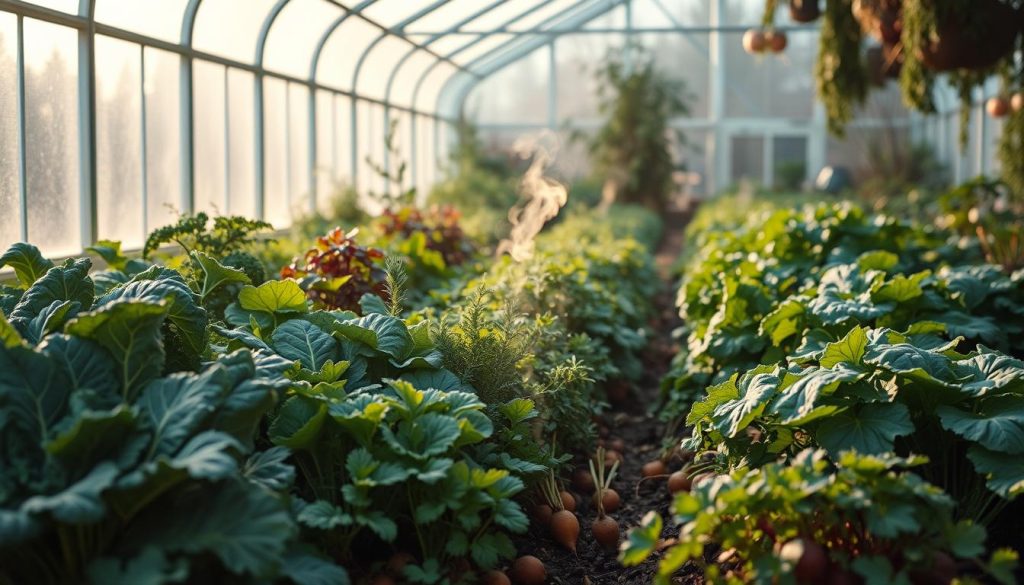
Succession planting means planting a little bit every 2-3 weeks. This way, you always have something new to harvest.
Keep a planting calendar to keep track of when to plant. Quick-growing veggies like radishes need planting every 10-14 days. Slower-growing ones like broccoli might only need planting once a month.
Spring and Summer Cultivation Methods
When it gets warmer, your greenhouse needs a change. Use shade cloth to block some sunlight in summer. Grow heat-loving crops like tomatoes and peppers in the greenhouse.
Good ventilation is key in summer. Automatic vents help keep the temperature right, even when you’re not there. Make sure plants have enough space for air to move.
Fall Transition and Preparation
Fall is a big change in the greenhouse. Replace summer crops with cool-season ones. September and October are great for starting winter crops.
Also, fall is the time to refresh your soil. Use compost and organic amendments to keep your soil healthy all year.
Extending Harvests into Colder Months
Make your greenhouse a cozy place for plants in winter. Use water-filled containers to keep the temperature steady. Row covers add extra protection for sensitive plants.
| Season | Recommended Crops | Planting Time | Special Considerations |
|---|---|---|---|
| Winter | Kale, spinach, mâche, carrots | Late fall for winter harvest | Focus on cold-hardy varieties; provide minimal heating |
| Spring | Lettuce, peas, radishes, beets | Late winter to early spring | Monitor for temperature fluctuations; ventilate on sunny days |
| Summer | Tomatoes, peppers, cucumbers | Early spring for summer harvest | Provide shade; increase ventilation; monitor for pests |
| Fall | Broccoli, cabbage, turnips, herbs | Late summer for fall harvest | Prepare for decreasing light; clean and sanitize growing areas |
Adjust your planting to fit each season. Your greenhouse will be a year-round food factory. Keep notes on what works for you. This will help you grow more food all year.
Sustainable Practices in Greenhouse Gardening
A greenhouse is a perfect place for growing plants in a way that’s good for the planet. By using eco-friendly methods, gardeners can cut down on waste and make plants healthier. This approach combines old wisdom with new technology, making gardening better for nature.
Water Conservation and Collection Systems
Managing water is key to a green greenhouse. Collecting rainwater from the roof is a great way to get water for plants. You can start with simple systems like gutters and barrels, or go for more complex setups.
Drip irrigation is another smart move. It sends water straight to the roots, saving water and preventing diseases. You can set it up to water plants automatically, based on their needs.
Recycling water is also a big help. It captures and filters runoff water, so it can be used again. This method cuts down on water use and keeps plants happy.
Energy-Efficient Heating and Cooling Solutions
Designing your greenhouse well can save a lot of energy. Using the sun’s heat and choosing the right materials can keep temperatures just right. This way, your greenhouse stays cozy all year.
Using things like water barrels to store heat is another smart trick. They help keep the temperature steady, so you might not need to use heaters as much.
For when you do need to use energy, solar panels are a good choice. They can power fans, heaters, and even irrigation systems. Even a small solar setup can make a big difference.
Integrated Pest Management for Enclosed Spaces
Integrated pest management (IPM) is a smart way to deal with pests. It starts with keeping things clean and using plants that pests don’t like. It also includes using barriers to keep pests out.
Watching for pests regularly is important. Use sticky traps and check plants often to catch problems early. This way, you can avoid using too many chemicals.
Beneficial Insects and Organic Controls
Bringing in good bugs can help keep pests away naturally. Ladybugs, lacewings, and wasps are great at controlling pests without harming plants. They help keep your greenhouse balanced.
| Beneficial Organism | Target Pest | Application Method | Effectiveness |
|---|---|---|---|
| Ladybugs | Aphids, mites, scale insects | Release in evening hours | High for small infestations |
| Nematodes | Soil-dwelling pests | Soil drench application | Moderate to high |
| Lacewings | Aphids, thrips, mealybugs | Release eggs on cards | High for multiple pests |
| Predatory mites | Spider mites, thrips | Sprinkle on affected plants | Very high for specific pests |
When natural controls aren’t enough, organic treatments are a good choice. Options like insecticidal soaps and neem oil are safe for plants and the environment. They break down quickly, leaving no harmful residue.
By using these sustainable methods, gardeners can grow plants in a way that’s good for the planet. It might cost a bit more at first, but it saves money and improves crop quality over time.
Advanced Growing Techniques for Maximum Productivity
There’s more to greenhouse gardening than the basics. Advanced techniques can greatly increase your harvest while saving resources. Let’s dive into how to elevate your greenhouse gardening.
Hydroponics and Soilless Growing Methods
Hydroponics changes the game by ditching soil. Plants grow in water rich with nutrients, leading to faster growth and higher yields. This method uses up to 90% less water than traditional gardening and can produce crops up to 30% faster.
Soilless media like coco coir, perlite, and rockwool are great alternatives. They offer better drainage and aeration while being lightweight and disease-resistant.
Nutrient Film Technique and Deep Water Culture
Nutrient Film Technique (NFT) and Deep Water Culture (DWC) are top choices for greenhouses. NFT has a thin film of nutrients flowing over plant roots in shallow channels. It’s perfect for leafy greens and herbs.
DWC suspends plants in platforms above nutrient solution, with roots in oxygenated water. It’s great for larger plants like tomatoes and peppers that need constant water and nutrients.
| Hydroponic System | Best Plants | Setup Difficulty | Maintenance Level | Space Efficiency |
|---|---|---|---|---|
| Nutrient Film Technique | Lettuce, Herbs, Spinach | Moderate | Low | High |
| Deep Water Culture | Tomatoes, Peppers, Cucumbers | Easy | Low | Moderate |
| Drip System | Most Vegetables, Berries | Moderate | Medium | High |
| Ebb and Flow | Flowers, Herbs, Leafy Greens | Moderate | Medium | High |
Vertical Farming to Maximize Limited Space
Vertical farming uses your greenhouse’s vertical space to grow more. This method can triple or quadruple your growing area without expanding your greenhouse.
Trellising is great for vining crops like cucumbers, beans, and peas. Tiered shelving systems let you stack plants efficiently. Hanging baskets are perfect for trailing herbs and strawberries.
When designing vertical systems, think about light penetration. Place taller plants on the north side to avoid shading. Use reflective materials to bounce light into shadowed areas.
Plant Propagation and Seed Starting Strategies
Mastering plant propagation creates a self-sustaining greenhouse ecosystem. Taking cuttings from healthy plants lets you multiply your favorites without extra cost. Soft-stem cuttings from herbs and houseplants root well in water or a light growing medium.
Division is great for perennial herbs and flowers, giving you multiple plants from one established specimen. Saving seeds from your best producers ensures you have garden-adapted varieties suited to your greenhouse.
Creating the Perfect Germination Environment
Successful seed starting needs careful attention to environmental factors. Most seeds germinate best between 65-75°F with consistent moisture. Heat mats provide bottom warmth that speeds germination, while humidity domes keep moisture levels right for emerging seedlings.
Different plant families have specific light needs during germination. While tomatoes and peppers can germinate in darkness, lettuce seeds need light to sprout. A simple LED grow light positioned 2-3 inches above seed trays provides ideal conditions for most seedlings once they emerge.
Overcoming Common Greenhouse Challenges
Greenhouse gardening is rewarding but comes with challenges. Knowing these obstacles and how to solve them is key. This ensures your greenhouse stays productive all year.
Managing Humidity and Ventilation Issues
Good air flow is vital for plant health in greenhouses. High humidity can cause condensation, leading to disease. Use automated vents to keep humidity in check.
In summer, fans help prevent heat buildup. In winter, carefully manage ventilation to avoid losing heat. Many use roof vents, side vents, and fans for climate control.
Preventing and Treating Plant Diseases
Start by creating a space that naturally fights disease. Keep plants far apart for better air flow. Water at soil level to keep leaves dry.
Fungal Problems and Their Solutions
Fungi like powdery mildew and gray mold are common in greenhouses. Catching them early is crucial. Remove sick plants and improve air flow.
Use natural controls like beneficial insects first. If needed, use organic or conventional treatments. This keeps your plants healthy and fights disease.
Balancing Initial Investment with Long-Term Benefits
Building a greenhouse costs a lot upfront. But, growing year-round can save money. Compare your savings to the cost to see the value.
Cost-Saving Tips for Budget Gardeners
Begin with a small, affordable greenhouse. Grow and expand as you can. Use old windows or plastic for cheap structures. DIY systems with thermostats and fans are cheaper than commercial ones.
| Common Challenge | Budget Solution | Mid-Range Solution | Premium Solution |
|---|---|---|---|
| High Humidity | Manual venting, oscillating fans | Automatic vent openers, dehumidifier | Integrated climate control system |
| Temperature Fluctuations | Thermal mass (water barrels), bubble wrap insulation | Electric heaters, shade cloth | Geothermal heating, automated shade systems |
| Fungal Diseases | Improved spacing, manual pruning | Organic fungicides, circulation fans | UV sterilization, automated humidity control |
| High Energy Costs | Solar thermal collectors, cold frames | Insulated panels, energy curtains | Solar PV systems, smart controllers |
The Growing Future of Home Greenhouse Cultivation
Home food production is changing fast with better greenhouse tech. Now, you can check on your plants from anywhere with your phone. LED lights also make sure plants grow well all year.
New materials for greenhouses help with keeping in heat and letting in light. This makes growing plants cheaper in different places. It’s turning gardening into a way to grow your own food.
Indoor farming is changing how we see food safety. Growing food at home means fresher, healthier food. People are using vertical farming to grow more in less space.
Greenhouse projects are also coming together in communities. These projects share space, teach skills, and work together. They help build strong food networks in local areas.
Greenhouses are becoming key for living sustainably. They’re not just for growing plants. They’re a step toward being self-sufficient and caring for our planet.
The future of greenhouses is about more than just plants. It’s about a better relationship with our food and the earth.

